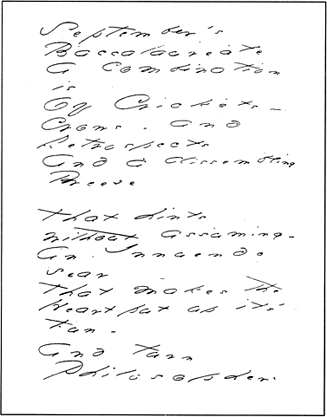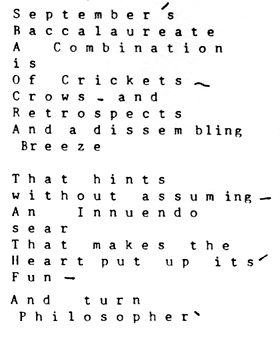alerts(
Some Notes on Visual Intentionality in Emily Dickinson

from the handwritten manuscripts of Emily Dickinson
(Editor's Note: At the recent Emily Dickinson/H.D. conference held at San Jose State University, Susan Howe gave a slide lecture called "The Illogic of Sumptuary Values," in which she compared the Thomas Johnson versions of E.D. with The Manuscript Books of E.D., edited by Ralph Franklin. Howe showed slides of Dickinson's handwritten manuscripts (the actual lineation on the pages collected in the fascicles) and introduced the question of intentionality, from the poet's point-of-view, discussing not only the radically different choice of line break in the originals (as opposed to the cleaned-up versions) but also the visual intentionality of Dickinson's spaces, marks, crosses, dashes, etc. Because we feel that these issues continue to be relevant for modernist scholarship and current poetic practice among innovative women writers, we present an excerpted version of this talk, and have also included several remarks from another of Howe's lectures delivered at New College, San Francisco and recently published in Ironwood #28, Vol. 14, No. 2.*)
An idea of the author Emily Dickinson--her symbolic value and aesthetic function--has been shaped by The Poems of Emily Dickinson, including variant readings critically compared with all known manuscripts, edited by Thomas H. Johnson, and first published by the Belknap Press of Harvard University, in 1955. For a long time I believed that this editor had given us the poems as they looked. Thirty-one years later, The Manuscript Books of Emily Dickinson, edited by Ralph Franklin, and again published by the Belknap Press of Harvard University, Cambridge, and London, show me that in a system of restricted exchange, the subject-creator and her art in its potential gesture, were domesticated and occluded by an assumptive privileged Imperative.
![]() •
•
Thomas H. Johnson's variorum edition did restore the poet's idiosyncratic spelling, punctuation (the famous dashes), and word variants to her poems. He called his Introduction "Creating the Poems" then gave their creator a male muse-Minister. He arranged her "verses" into hymn-like stanzas with little variation in form and no variation of cadence. By choosing a sovereign system for her line endings-- his pre-appointed Plan, he established the constraints of a strained positivity. Copious footnotes, numbers, comparisons, and chronologies mask his authorial role.
•
![]()
![]() September's Baccalaureate
September's Baccalaureate
![]() A combination is
A combination is
![]() Of Crickets--Crows--and Retrospects
Of Crickets--Crows--and Retrospects
![]() And a dissembling Breeze
And a dissembling Breeze
![]()
![]() That hints without assuming--
That hints without assuming--
![]() An Innuendo sear
An Innuendo sear
![]() That makes the Heart put up its Fun
That makes the Heart put up its Fun
![]() And turn Philosopher.
And turn Philosopher.
![]()
![]() Johnson, p.884, #1271
Johnson, p.884, #1271
![]()
![]() •
•
When readers, poets, students, critics, scholars, and biographers persist in using Thomas Johnson's edition of the complete works,
The Complete Poems of Emily Dickinson,
as the ur-text, they ignore her radical rejection of Poetry as a commodity. Johnson· created the impression that a definitive textual version could exist. The Manuscript Books of Emily Dickinson
shows how misleading such an authoritative reading can be.*
![]() •
•
I wonder at Ralph Franklin's conclusion as stated in two terse letters, that these facsimiles are not to be considered as artistic structures.
Excerpted letters, Franklin to Howe:
"I do not believe. . . that the fascicles are artistic structures or that they were intended for other readers . . . . Your remarks about her line breaks are interesting. Doesn't much of your argument depend on your assumption that one (she) reads in lines
or
parts of lines?
What happens to it if the form lurking in the mind is the
stanza?"
|
"I transcribed the letters line-for-physical line solely for purposes of reference with the facsimiles. If I were doing a text as such, I would surely opt for run-on treatment since it is prose and there is no expected (genre) form generating the line. In the poems, of course, there is such a form and that is what I intend to follow--not the accidents of physical line breaks on the paper. Except of course--where they coincide."
|
| 6/1/86
|
![]() •
•
As a poet I cannot assert that Dickinson composed in stanzas and was careless about line breaks. In the precinct of Poetry, a word, the space around a word, each letter, every mark silence or sound, volatizes an inner law of form; moves on a rigorous line.

Look carefully at one of Dickinson's manuscripts from the 1870's, the ones Ralph Franklin calls "careless," and you will see what gets lost in any typeface. In typography's mirror of production, words reflect only the shadow of their inception. Try to copy her calligraphy; retrace one sweeping S, a, or C, and you will know how sure her touch was/is. Shapes and letters pun on and play with each other. Messages are delivered by marks. All redundancies are cut away to recover the innocence of the eye.
![]() •
•
The
Manuscript
Books
complicate T.H. Johnson's criteria for poetic order. These lines traced by pencil or in ink on paper were formed by an innovator. This invisible handwritten sequence establishes an enunciative clearing outside intention while obeying intuition's agonistic necessity.
![]() •
•
Susan Howe's typed version from the E.D. fascicle manuscript book, p.1380:

If Johnson has put up the Heart's Fun by changing "September's" form, my typed version doesn't show the way the curves in the first section are mated or contradicted by vertical slashes running through the second section. Even a reproduction of the handwritten text will lose some impact of the original document unless the three words of the third section ("and turn philosopher"), words about change and the process of turning, are alone on the back of the original page. As in recorded history, what gets left out may be the most important part.
![]() •
•
![]()
Because Emily Dickinson published almost nothing in her lifetime, it is difficult, if not impossible, to fully understand her final intentions for each poem's printed form. Are these works poems? Are they prayers, hymns, meditations, aphorisms, sketches, fragments--or simply drafts and splinters? What labor do they require from the reader? Are new requirements engendered in a discourse uprooted by Suddenness and ambiguity? There are political implications here. A reader drawn into the
process
of her unremitting spontaneity will find in Contradiction's originary ebullience an end to passive consumerism.*
![]() •
•
![]()
One hundred years after her death if I quote from her poems or letters in a book, and I use either the Johnson edition of the Complete Poems or Franklin's edited Manuscript Books as the source, I must obtain permission from and pay a fee to The President and Fellows of Harvard College and the Trustees of Amherst College.
"Is this the Hope that opens and shuts, like the eye of the Wax Doll?--Your Scholar--" [Letter 553]
![]() •
•
Poetry is never a personal possession. The text was a vision and gesture before it became sign and coded exchange in a political economy of value. At the moment these manuscripts are accepted into the property of our culture, their scholar-author escapes the ritual of framing--symmetrical order and arrangement.
* Passages quoted are from "Women and Their Effect in the Distance," Ironwood 28, Fall 1986.
Susan Howe is the author of
My Emily Dickinson,
North Atlantic Books, and several volumes of poetry, including
Pythagorean Silence,
Montemora, and
Defenestration of Prague,
The Kulchur Foundation.

Metafictions of Nicole Brossard
"Analysis: so that for me lips are represented as a motivation to follow mouths replete with affinities. In that way, I am working so that the convulsive habit of initiating girls to the male as in a contemporary practice of lobotomy will be lost. I want to see in fact the form of women organizing in the trajectory of the species."
![]() •
•
![]() •
•
"It's night in the sentence." I am reading picture theory by Nicole Brossard, also French Kiss, La lettre aérienne carried into the streets of Montreal, a multitude of women emerge, hands in hair, go forth speaking in barricades from their radio sets pounding in the fathoms thrown at last, the Sour mothers.
Something wet to be known, makes you watch in silence as she trades one set of strategies for another (desire for real). "breath flowers organ orange everything slides into the mouth," displays a certain effervescence, relationships to new conditions of existence, girls in shorts, archery intimate and political splendor. It speaks above the codes. "I was with some women then." This is a title, The State of Difference, demonstration of method, contiguous with a relentless questioning of the literary thing, how it works, does she choose to struggle with language in order to approach a degree of, shall we say, fit between the female subject and her speech. These are delicate mechanisms of translation, ferrying across the swimming signifiers, causing bankruptcy among tongues rooted "to the unavowable & patriarchal lies." "Une femme est une femme." Except this fiction as disappearance, would have to be turned in. "The buying back of the text in its child's mirror."
She is in every state of excitation, wild yellow attributes of writing: struggle & research envelope the poem neck & neck, against the general economy, the world at large rolling, sprawling, "all these little I's that capitalism has reduced to string puppets." Never without future spendings I read a multiplication of traces, a mesh, like tropical netting, red herbs, also an indubitable ardor for rhythm, to lie down next to the subject, have eyes, enamored of language like truancy, traversing a text in a flash, sure of being figured, comme ça, without discussion, for the first time.
All quotations from Nicole Brossard's books:
These Our Mothers,
Coach House, tr. Barbara Godard picture theory,
Nouvelle Optique, 1982 (French only)
La lettre aérienne, Les éditions du remue-ménage, Montreal, 1985 (English translation forthcoming from Toronto Women's Press.)
La lettre aérienne, Les éditions du remue-ménage, Montreal, 1985 (English translation forthcoming from Toronto Women's Press.)
